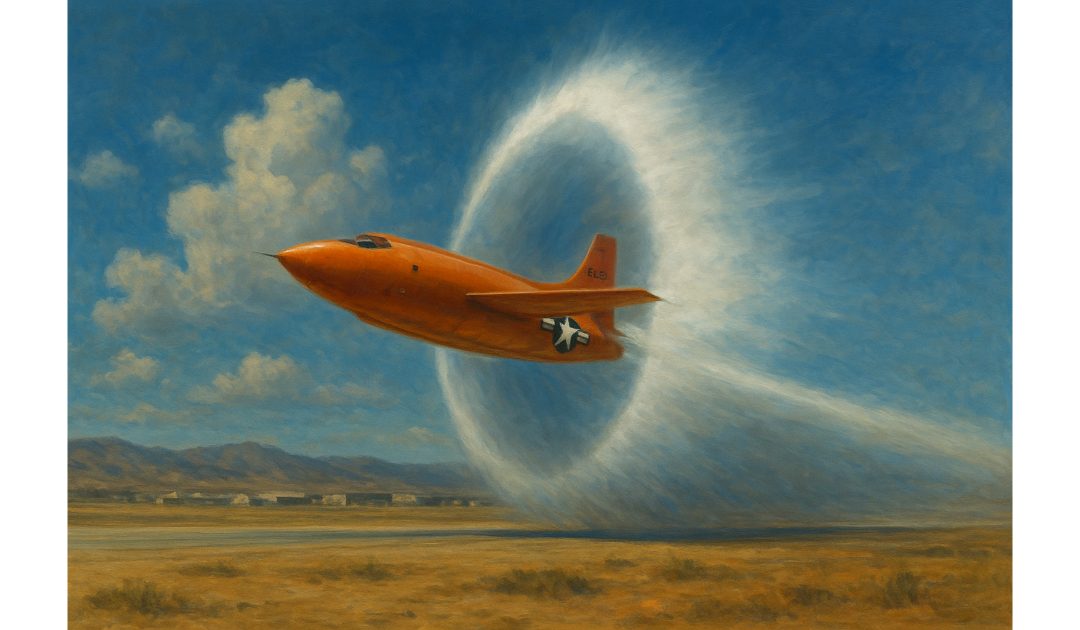I decided to write about Chuck Yeager today, because on the 14th of October, 1947, he broke the sound barrier in level flight over Muroc Army Airfield in California, flying a Bell XS-1. I might have written about Mary Queen of Scots, because her trial began on this date in 1586, but I’ve written about her before. For an Englishman it’s quite hard to gloss over the Battle of Hastings, which was also fought on the 14th of October. I don’t think I need to mention which year.
Chuck Yeager, an iconic figure in aviation history, epitomised courage, skill, and innovation. Born on the 13th of February, 1923, in Myra, West Virginia, Yeager grew up in a modest rural environment. The son of a gas driller, he developed an early interest in mechanics and hunting, skills that would later serve him well in his aviation career.
Yeager enlisted in the U.S. Army Air Forces in September 1941, shortly before the United States entered World War II. He began as an aircraft mechanic but soon transferred to pilot training due to the demand for aviators during the war. His natural aptitude for flying became immediately apparent, and he earned his pilots wings in 1943. Assigned to the 363rd Fighter Squadron, Yeager flew the P-51 Mustang, a highly agile fighter aircraft, and quickly distinguished himself as a talented combat pilot.
During World War II, Yeager’s combat achievements were extraordinary. He shot down 13 enemy aircraft, including five in a single day, earning him the title of “ace in a day.” Notably, after being shot down over France, he evaded capture with the assistance of the French Resistance. Despite regulations that typically prohibited downed pilots from returning to combat to prevent intelligence breaches if captured again, Yeager successfully appealed to General Dwight D. Eisenhower and resumed flying missions.
After the war, Yeager’s career took a historic turn. He became a test pilot at Muroc Army Air Field (now Edwards Air Force Base) in California. It was here, on the 14th of October, 1947, that Yeager achieved what many had thought impossible: he broke the sound barrier in level flight. Piloting the Bell X-1, a rocket-powered aircraft he named “Glamorous Glennis” after his wife, Yeager reached Mach 1.06 (700 miles per hour) at an altitude of 45,000 feet. This monumental achievement marked the dawn of the supersonic age and dramatically advanced aeronautical engineering and aviation capabilities.
Yeager’s feat was even more remarkable considering he was suffering from broken ribs sustained in a horse-riding accident just days prior. Despite the injury, he managed to keep it hidden from his superiors, demonstrating not only physical resilience but an indomitable spirit. His success was a testament to his extraordinary piloting skills, unyielding determination, and fearless nature.
Following his supersonic achievement, Yeager continued to work as a test pilot, pushing the boundaries of aviation. He flew numerous experimental aircraft, contributing to the development of high-speed, high-altitude flight. Yeager’s ability to intuitively understand aircraft performance and his unmatched skill in handling challenging situations made him an invaluable asset in the field of aeronautics.
In the 1950s and 1960s, Yeager transitioned back into military command roles. He led various fighter squadrons and wings, including during the Vietnam War, where he flew combat missions to maintain operational proficiency. His leadership and tactical expertise were highly respected, and he played a significant role in training the next generation of fighter pilots.
Throughout his career, Yeager received numerous accolades and honours. His military decorations include the Distinguished Flying Cross, the Silver Star, and the Air Force Distinguished Service Medal, among others. In 1976, he was awarded the Congressional Gold Medal, one of the highest civilian honours in the United States. His legacy was further cemented through his portrayal in Tom Wolfe’s book “The Right Stuff” and the subsequent film, which highlighted the bravery and pioneering spirit of test pilots like Yeager.
After retiring from the Air Force as a brigadier general in 1975, Yeager remained active in aviation circles. He continued to fly, often participating in commemorative events and airshows, and served as a consultant for aerospace companies. His passion for flight never waned, exemplified by his participation in anniversary flights recreating his historic supersonic achievement well into his later years.
Yeager’s personal life was marked by his enduring marriage to Glennis, with whom he had four children. After her passing in 1990, he remarried in 2003. Known for his straightforward, no-nonsense attitude, Yeager was both admired and remembered for his humility despite his extraordinary accomplishments. He often credited his success to luck, good training, and the support of his fellow aviators.
Chuck Yeager passed away on the 7th of December, 2020, at the age of 97. His death marked the end of an era, but his legacy continues to inspire aviators and adventurers worldwide. Yeager’s life embodies the spirit of exploration and the relentless pursuit of excellence.

